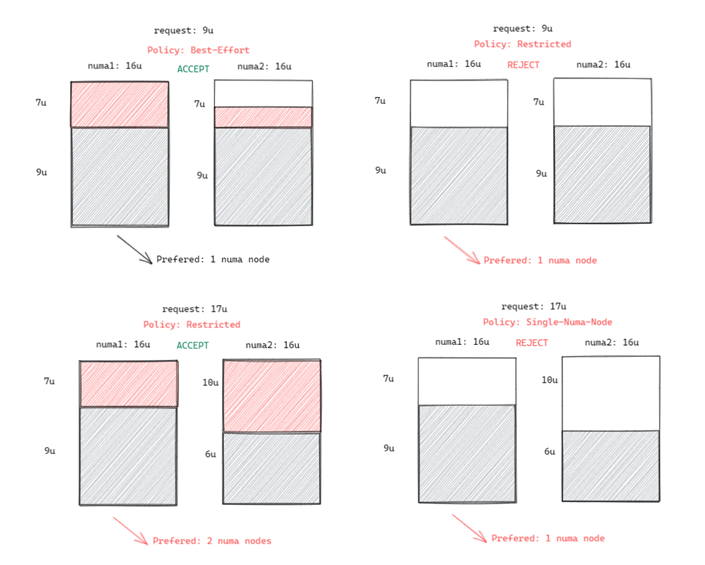NUMA亲和性调度
背景信息
当节点运行许多CPU绑定的Pod时,工作负载可以迁移到不同的CPU核心,这取决于Pod是否被限制以及调度时哪些CPU核心可用。许多工作负载对此迁移不敏感,因此在没有任何干预的情况下工作正常。但是,在CPU缓存亲和性和调度延迟显著影响工作负载性能的工作负载中,如果CPU是从不同的NUMA节点分配的,会导致额外的延迟。因此kubelet允许使用拓扑管理器(Topology Manager)替代CPU管理策略来确定节点的分配。
CPU Manager和拓扑管理器都是kubelet组件,但有以下限制:
- K8s默认调度器不感知NUMA拓扑。因此,可能会调度到不满足NUMA拓扑要求的节点上,然后工作负载实例启动失败。这对于Tensorflow作业来说是不可接受的。如果节点上有任何工作进程或ps失败,则作业将失败。
- 管理器是节点级的,导致无法匹配整个集群中NUMA拓扑的最佳节点。
Volcano的目标是解决调度程序NUMA拓扑感知的限制,以便实现以下目标:
- 避免将Pod调度到NUMA拓扑不匹配的节点。
- 将Pod调度到NUMA拓扑的最佳节点。
更多资料请查看社区NUMA亲和性插件指导链接:https://github.com/volcano-sh/volcano/blob/master/docs/design/numa-aware.md
支持范围
- 支持CPU资源拓扑调度
- 支持Pod级拓扑策略
Pod调度预测
当Pod设置了拓扑策略时,Volcano会根据Pod设置的拓扑策略预测匹配的节点列表。调度过程如下:
- 根据Pod设置的Volcano拓扑策略,筛选具有相同策略的节点。Volcano提供的拓扑策略与拓扑管理器相同。
- 在设置了相同策略的节点中,筛选CPU拓扑满足该策略要求的节点进行调度。
|
Volcano拓扑策略 |
节点调度行为 |
|
|---|---|---|
|
1.筛选具有相同策略的节点 |
2.节点的CPU拓扑满足该策略的要求 |
|
|
none |
无筛选行为:
|
- |
|
best-effort |
筛选拓扑策略同样为“best-effort”的节点:
|
尽可能满足策略要求进行调度: 优先调度至单NUMA节点,如果单NUMA节点无法满足CPU申请值,允许调度至多个NUMA节点。 |
|
restricted |
筛选拓扑策略同样为“restricted”的节点:
|
严格限制的调度策略:
|
|
single-numa-node |
筛选拓扑策略同样为“single-numa-node”的节点:
|
仅允许调度至单NUMA节点。 |
假设单个节点CPU总量为32U,由2个NUMA节点提供资源,分配如下:
|
工作节点 |
节点拓扑策略 |
NUMA节点1上的CPU总量 |
NUMA节点2上的CPU总量 |
|---|---|---|---|
|
节点-1 |
best-effort |
16 |
16 |
|
节点-2 |
restricted |
16 |
16 |
|
节点-3 |
restricted |
16 |
16 |
|
节点-4 |
single-numa-node |
16 |
16 |
Pod设置拓扑策略后,调度情况如图1所示。
- 当Pod的CPU申请值为9U时,设置拓扑策略为“best-effort”,Volcano会匹配拓扑策略同样为“best-effort”的节点-1,且该策略允许调度至多个NUMA节点,因此9U的申请值会被分配到2个NUMA节点,该Pod可成功调度至节点-1。
- 当Pod的CPU申请值为9U时,设置拓扑策略为“restricted”,Volcano会匹配拓扑策略同样为“restricted”的节点-2/节点-3,且单NUMA节点CPU总量满足9U的申请值,但单NUMA节点剩余可用的CPU量无法满足,因此该Pod无法调度。
- 当Pod的CPU申请值为17U时,设置拓扑策略为“restricted”,Volcano会匹配拓扑策略同样为“restricted”的节点-2/节点-3,且单NUMA节点CPU总量无法满足17U的申请值,可允许分配到2个NUMA节点,该Pod可成功调度至节点-3。
- 当Pod的CPU申请值为17U时,设置拓扑策略为“single-numa-node”,Volcano会匹配拓扑策略同样为“single-numa-node”的节点,但由于单NUMA节点CPU总量均无法满足17U的申请值,因此该Pod无法调度。
调度优先级
不管是什么拓扑策略,都是希望把Pod调度到当时最优的节点上,这里通过给每一个节点进行打分的机制来排序筛选最优节点。
原则:尽可能把Pod调度到需要跨NUMA节点最少的工作节点上。
打分公式如下:
score = weight * (100 - 100 * numaNodeNum / maxNumaNodeNum)
参数说明:
- weight:NUMA Aware Plugin的权重。
- numaNodeNum:表示工作节点上运行该Pod需要NUMA节点的个数。
- maxNumaNodeNum:表示所有工作节点中该Pod的最大NUMA节点个数。
例如,假设有三个节点满足Pod的CPU拓扑策略,且NUMA Aware Plugin的权重设为10:
- Node A:由1个NUMA节点提供Pod所需的CPU资源,即numaNodeNum=1
- Node B:由2个NUMA节点提供Pod所需的CPU资源,即numaNodeNum=2
- Node C:由4个NUMA节点提供Pod所需的CPU资源,即numaNodeNum=4
则根据以上公式,maxNumaNodeNum=4
- score(Node A) = 10 * (100 - 100 * 1 / 4) = 750
- score(Node B) = 10 * (100 - 100 * 2 / 4) = 500
- score(Node C) = 10 * (100 - 100 * 4 / 4) = 0
因此最优节点为Node A。
Volcano开启NUMA亲和性调度
- 开启静态(static)CPU管理策略,具体请参考 开启CPU管理策略。
- 配置CPU拓扑策略。
- 登录CCE控制台,单击集群名称进入集群,在左侧选择“节点管理”,在右侧选择“节点池”页签,单击节点池名称后的“ 配置管理”。
- 将kubelet的拓扑管理策略(topology-manager-policy)的值修改为需要的CPU拓扑策略即可。
有效拓扑策略为“none”、“best-effort”、“restricted”、“single-numa-node”,具体策略对应的调度行为请参见Pod调度预测。
- 开启numa-aware插件功能和resource_exporter功能。
Volcano 1.7.1及以上版本
- 登录CCE控制台,单击集群名称进入集群,单击左侧导航栏的“插件中心”,在右侧找到Volcano,单击“编辑”,并在“参数配置”中设置Volcano调度器配置参数。
... "default_scheduler_conf": { "actions": "allocate, backfill, preempt", "tiers": [ { "plugins": [ { "name": "priority" }, { "name": "gang" }, { "name": "conformance" } ] }, { "plugins": [ { "name": "drf" }, { "name": "predicates" }, { "name": "nodeorder" } ] }, { "plugins": [ { "name": "cce-gpu-topology-predicate" }, { "name": "cce-gpu-topology-priority" }, { "name": "cce-gpu" }, { // add this also enable resource_exporter "name": "numa-aware", // the weight of the NUMA Aware Plugin "arguments": { "weight": "10" } } ] }, { "plugins": [ { "name": "nodelocalvolume" }, { "name": "nodeemptydirvolume" }, { "name": "nodeCSIscheduling" }, { "name": "networkresource" } ] } ] }, ...
Volcano 1.7.1以下版本- Volcano插件开启resource_exporter_enable参数,用于收集节点numa拓扑信息。
{ "plugins": { "eas_service": { "availability_zone_id": "", "driver_id": "", "enable": "false", "endpoint": "", "flavor_id": "", "network_type": "", "network_virtual_subnet_id": "", "pool_id": "", "project_id": "", "secret_name": "eas-service-secret" } }, "resource_exporter_enable": "true" }开启后可以查看当前节点的numa拓扑信息。kubectl get numatopo NAME AGE node-1 4h8m node-2 4h8m node-3 4h8m
- 启用Volcano numa-aware算法插件。
kubectl edit cm -n kube-system volcano-scheduler-configmap
kind: ConfigMap apiVersion: v1 metadata: name: volcano-scheduler-configmap namespace: kube-system data: default-scheduler.conf: |- actions: "allocate, backfill, preempt" tiers: - plugins: - name: priority - name: gang - name: conformance - plugins: - name: overcommit - name: drf - name: predicates - name: nodeorder - plugins: - name: cce-gpu-topology-predicate - name: cce-gpu-topology-priority - name: cce-gpu - plugins: - name: nodelocalvolume - name: nodeemptydirvolume - name: nodeCSIscheduling - name: networkresource arguments: NetworkType: vpc-router - name: numa-aware # add it to enable numa-aware plugin arguments: weight: 10 # the weight of the NUMA Aware Plugin
- 登录CCE控制台,单击集群名称进入集群,单击左侧导航栏的“插件中心”,在右侧找到Volcano,单击“编辑”,并在“参数配置”中设置Volcano调度器配置参数。
使用Volcano设置NUMA亲和性调度
- 以下为使用Volcano设置NUMA亲和性调度的示例。
- 示例一:在无状态工作负载中配置NUMA亲和性。
kind: Deployment apiVersion: apps/v1 metadata: name: numa-tset spec: replicas: 1 selector: matchLabels: app: numa-tset template: metadata: labels: app: numa-tset annotations: volcano.sh/numa-topology-policy: single-numa-node # set the topology policy spec: containers: - name: container-1 image: nginx:alpine resources: requests: cpu: 2 # 必须为整数,且需要与limits中一致 memory: 2048Mi limits: cpu: 2 # 必须为整数,且需要与requests中一致 memory: 2048Mi imagePullSecrets: - name: default-secret - 示例二:创建一个Volcano Job,并使用NUMA亲和性。
apiVersion: batch.volcano.sh/v1alpha1 kind: Job metadata: name: vj-test spec: schedulerName: volcano minAvailable: 1 tasks: - replicas: 1 name: "test" topologyPolicy: best-effort # set the topology policy for task template: spec: containers: - image: alpine command: ["/bin/sh", "-c", "sleep 1000"] imagePullPolicy: IfNotPresent name: running resources: limits: cpu: 20 memory: "100Mi" restartPolicy: OnFailure
- 示例一:在无状态工作负载中配置NUMA亲和性。
- NUMA调度分析。
假设NUMA节点情况如下:
工作节点
节点策略拓扑管理器策略
NUMA 节点 0 上的可分配 CPU
NUMA 节点 1 上的可分配 CPU
node-1
single-numa-node
16U
16U
node-2
best-effort
16U
16U
node-3
best-effort
20U
20U
则根据以上示例,
- 示例一中,Pod的CPU申请值为2U,设置拓扑策略为“single-numa-node”,因此会被调度到相同策略的node-1。
- 示例二中,Pod的CPU申请值为20U,设置拓扑策略为“best-effort”,它将被调度到node-3,因为node-3可以在单个NUMA节点上分配Pod的CPU请求,而node-2需要在两个NUMA节点上执行此操作。
确认NUMA使用情况
您可以通过lscpu命令查看当前节点的CPU概况:
# 查看当前节点的CPU概况 lscpu ... CPU(s): 32 NUMA node(s): 2 NUMA node0 CPU(s): 0-15 NUMA node1 CPU(s): 16-31
然后查看NUMA节点使用情况。
# 查看当前节点的CPU分配
cat /var/lib/kubelet/cpu_manager_state
{"policyName":"static","defaultCpuSet":"0,10-15,25-31","entries":{"777870b5-c64f-42f5-9296-688b9dc212ba":{"container-1":"16-24"},"fb15e10a-b6a5-4aaa-8fcd-76c1aa64e6fd":{"container-1":"1-9"}},"checksum":318470969}
以上示例中表示,节点上运行了两个容器,一个占用了NUMA node0的1-9核,另一个占用了NUMA node1的16-24核。







